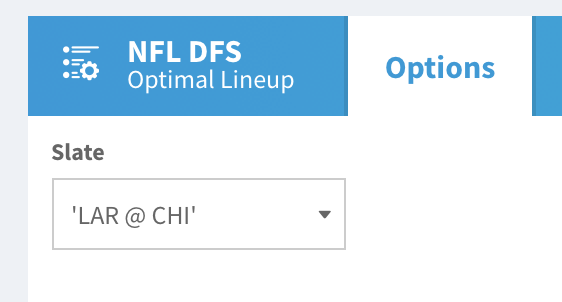Introducing Sharpstack, an Advanced Optimizer That Will Help You Dominate Daily Fantasy Sports

To win at daily fantasy, you're trying to predict what will happen. And that's what we're here for at numberFire -- to help you make accurate predictions.
In the NFL, a huge part of that is predicting game script. If a team is up huge, they are going to run the ball -- this makes defenses and ground-and-pound running backs perform well together. In a passing shootout, you want to stack your quarterback with one or more of his top receiving options.
Optimizers revolutionized daily fantasy sports. Most optimizers, including our own, take projections and come up with the top possible projected points (either in terms of the average expected points, or most potential upside). In order to select different stacks, the user is forced to manually input players or specific rules, which can be imperfect and tedious.
Stacking strategy also changes greatly depending on the player pool -- it makes sense to stack more heavily in small slates, and not as much in larger ones. In many optimizers, you can also add randomness into the equation to try to generate some unique lineups, but that randomness is usually just that: random.
Sharpstack looks historically to see how players at different positions perform together and then specializes that for each team and roster. If Tom Brady does well, it's much more likely that his receiving running back, James White, has a good game, than his pure rusher, Sony Michel. If Leonard Fournette has a good game, it's very likely the Jaguars defense did as well. And T.J. Yeldon, the team's pass-catching back, probably didn't.
Sharpstack takes these historical relationships and uses them to generate smart simulations for whatever slate you may be playing. Currently, we're rolling out single-game slates for FanDuel, but over the long term, we'll release all slates across sites.
We simulate your slate tens of thousands of times to see how it could possibly play out. Then, we pull the top lineup from each simulation and compare these against one another to find the best lineups over time. This way, you're maximizing your chances of winning by seeing which lineups were the best over all of the simulations (this can be based either on finishing position of the lineup, or expected points scored). This also allows us to add a dice roll -- generate random lineup -- feature, where we will run one full simulation of the slate and spit out the perfect lineup from that simulation.
How It Works
Start up top by selecting your slate.
Once you have a slate, you're ready to start generating lineups. Select the number of lineups to generate (up to 150) and click Generate Lineups. This will post 150 of the top lineups from the simulations for that slate.
Each player in the lineup will show the numberFire projected fantasy points and how many fantasy points that player scored in the simulated slate. For a single-game slate, we will also show you who the MVP should be for 1.5x bonus points.

At the very bottom, you will find a summary table that shows the average fantasy points scored by each player in the simulations, that player's exposure (in what percent of the optimal lineups that player was selected), and MVP percent (what percent of the lineups was that player selected as the MVP). This is extremely useful for building your own lineups, as it shows the top players to choose for the slate.

Here, Todd Gurley appeared in 60% of all lineups generated and was selected as MVP in 23.33% of them. Jared Goff was in fewer lineups (56.67%), but was actually the MVP more frequently at 25%.
You also have the option of generating one random simulated lineup by clicking Random Lineup. This does not guarantee to be one of the best lineups possible, but it means in that one simulation, it was the best lineup available.
Browse your lineups -- decide if there are specific players you would like to lock in or exclude, and then regenerate new lineups. As with our other tools, you can always see your locked in and excluded players at the top of the page.

Be aware, however, that if you have too many restrictions in terms of locking in players or excluding players, you may not generate the full number of requested lineups (or any lineups at all).

Finally, you have the option to export your generated lineups in CSV format for uploading to a DFS contest.
















